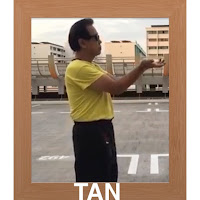SECTION 4 -- YIJINJING
Section 4 -- YiJinJing
The Main objective of this Section 4 -- YiJinJing is to train our tendons and sinews to transform them, from flaccid and frail to strong and sturdiness. The movements are done with hard compression to gentle relaxation, combining with breath works. Breathing is very important, because it is not about the air or oxygen, it is about delivering the prana vital energy to all the body parts, arms, hands and fingers. Combining with "Yi" or Intention, and bio-mechanics, you can maximize your physical potential. Make sure the tip of the tongue always touches the upper palate of the mouth.
Having tougher muscles and tendons means having better endurance, flexibility, more resistance and resilience. The exercises also invigorate the limbs and internal organs. If perform mindfully, it can integrate the Physical Body, Energetic Body and Mental Body. One will be able to summon the prana energy to the point of contact, increasing the sensitivity of touch, empowering the "stickiness" and therefore able to manipulate your opponent.
The Eighteen Hands of Sao Lim Wing Chun are instrumental in these exercises as they are the basic tools used in our training. Following are the brief description of the Eighteen Hands:-
1. Pak -- press the two palms tightly together
- exhale slowly for as long as you can
- then relax the arms and inhale into the Tan Tien
- hold your breath and ready for the next move
 2. Tan -- extend forward and press the forearm downwards
2. Tan -- extend forward and press the forearm downwards
- pressing the diaphragm downwards while exhaling and extending the forearm forward, pressing down at the same time
- feel your hands and forearms very heavy
- hold as long as you can
- then relax, inhale into Tan Tien and hold, ready for the next move
3. Huen -- rotate the hands slowly but forcefully, exerting rotational pressure at the wrist
- exhale slowly, at the same time rotate the hands slowly, keeping the elbows down and close to body
- feel your hands and forearms very heavy like hooking on the opponent's wrists or forearms
- hold as long as you can
- then relax, inhale into the Tan Tien and hold, ready for the next move
 4. Chum -- exert pressure and feel the qi at base of the knife hand and wrist
4. Chum -- exert pressure and feel the qi at base of the knife hand and wrist
- exhale slowly by pushing down the diaphragm and exert pressure at the root of the palms in a chopping motion
- hold as long as you can
- then relax, inhale into the Tan Tien and hold, ready for the next move
 5. Fuk -- exert forward and downwards pressure with the forearms, bring elbows together
5. Fuk -- exert forward and downwards pressure with the forearms, bring elbows together
- exhale slowly, extending the wrists forwards in the Fuk position
- keep elbows in and forearms downwards but not pressing down
- hold as long as you can
- then relax, inhale into the Tan Tien and hold, ready for the next move
 6. Wu -- exert power towards you and feel pressure between the bridge of hand and wrist
6. Wu -- exert power towards you and feel pressure between the bridge of hand and wrist
- from Fuk position, exhale slowly by pressing the diaphragm, pulling the neck of the hands backwards to the chest
- keep elbows down all the while, 'TUN" at the same time
- hold as long as you can
- then relax, inhale into the Tan Tien and hold, ready for the next move
7. Middle Bong -- extend forward energy with the wing hand and press side way at chest level
- moving from the centerline, extend the arms forward, pushing outwards
- all the while exhale slowly, pushing down the diaphragm
- use the torso core structural muscles to hold
- hold as long as you can
- then relax, inhale into the Tan Tien and hold, ready for the next move

8. Low Bong-- extend forward energy with the wing hand and press side way at belly level
- from the Middle Bong position, move down to the Low Bong position, pushing outwards side-way
- all the while exhale slowly, pushing down the diaphragm
- use the torso core structural muscles to hold
- hold as long as you can
- then relax, inhale into the Tan Tien and hold, ready for the next move
 9. High Bong-- extend forward energy with the wing hand and press side way at neck level
9. High Bong-- extend forward energy with the wing hand and press side way at neck level
- from the Low Bong position, move down to the High Bong position, pushing upwards diagonally
- all the while exhale slowly, pushing down the diaphragm
- use the torso core structural muscles to hold
- hold as long as you can
- then relax, inhale into the Tan Tien and hold, ready for the next move
10. Lap -- grip and pull down slowly with the torso's core muscles
- from the High Bong position, grasp and pull downwards diagonally to waist level while exhaling slowly
- all the while exhale slowly, pushing down the diaphragm
- use the torso core structural muscles to hold
- hold as long as you can
- then relax, inhale into the Tan Tien and hold, ready for the next move
11. Bui -- shooting fingers forwards at eye level, extending Qi to the fingers'tip
- from the Lap position, bring the hands to the solar plexus and shoot diagonally upwards to eye level, exhaling at the same time
- feel the Qi emitting at the fingers' tip
- extend and open all the joints, holding as long as you can
- then relax, inhale into the Tan Tien and hold, ready for the next move
12. Juk -- bring hands down obliquely with the torso's core muscles
- from the Bui position, bring to the Juk position, "Tun" at the same time exhaling slowly
- use the torso core structural muscles to hold
- hold as long as you can
- then relax, inhale into the Tan Tien and hold, ready for the next move
13. Kan -- knife hands strike downwards to the side and feeling tension on the forearms
- from Juk position, knife hand chop to the side, exhale slowly
- use the torso core structural muscles to hold
- hold as long as you can
- then relax, inhale into the Tan Tien and hold, ready for the next move
 14. Chui -- punch upwards to temple level, feeling tension on the upper arms and shoulders
14. Chui -- punch upwards to temple level, feeling tension on the upper arms and shoulders
- from Kan position, punch upwards slowly, exhale slowly by pushing down the diaphragm
- use the torso core structural muscles to hold
- hold as long as you can
- then relax, inhale into the Tan Tien and hold, ready for the next move
15. Tie -- pull back hands with shoulder blades and feeling tension in between the blades
- from Chui position, bring hands backwards slowly, exhale slowly by pushing down the diaphragm
- use the torso core structural muscles to hold
- hold as long as you can
- then relax, inhale into the Tan Tien and hold, ready for the next move
16. Tok -- in a striking motion, push up the palms, bring the elbows together
- from Tie position, bring hands forwards slowly, exhale slowly by pushing down the diaphragm
- use the torso core structural muscles to hold
- hold as long as you can
- then relax, inhale into the Tan Tien and hold, ready for the next move
17. Mong -- horizontal palm strike at eye level, feeling tension at the back of the arms
- from Tok position, change to Mong position, exhale slowly by pushing down the diaphragm
- use the torso core structural muscles to hold
- hold as long as you can
- then relax, inhale into the Tan Tien and hold, ready for the next move
18. Tai -- in a lifting motion, push up the palms, root of palms and forearms together
- from Mong position, change to Tai position, exhale slowly by pushing down the diaphragm
- use the torso core structural muscles to hold
- hold as long as you can
- then relax, inhale into the Tan Tien and hold, ready for the next move














Comments
Post a Comment